 In 1983, Congress passed the Orphan Drug Act, bringing with it the opportunity to advance the development of drugs for rare diseases. Since that time, the Food and Drug Administration (FDA) has approved more than 550 products to treat rare diseases.
In 1983, Congress passed the Orphan Drug Act, bringing with it the opportunity to advance the development of drugs for rare diseases. Since that time, the Food and Drug Administration (FDA) has approved more than 550 products to treat rare diseases.
The FDA established the Office of Orphan Products Development (OOPD) with a mission to advance the evaluation and development of products that hold promise in diagnosing or treating rare diseases. The FDA, the European Medicines Agency (EMA), and other global regulatory bodies have done much to help progress the development of rare disease drugs.
“There have been significant regulatory actions in the rare disease space, starting with the Orphan Drug Act that provides important incentives that have helped drive the development of innovative therapies to treat rare diseases," says Jonca Bull, M.D., VP of PPD Consulting.
“In the years since the Orphan Drug Act was passed, there has been compelling evidence that regulators have demonstrated flexibility in trial design that has expedited time to market for these specialty drugs," she adds. “The advantages are clear. More than one-third of new drug approvals in recent years have received orphan designation, providing unprecedented care for patients who previously had none."
An orphan drug status is assessed twice in the lifecycle of a medicinal product for an orphan disease.
The first evaluation occurs when the orphan drug designation (ODD) is assessed, says Dr. Barbara Dogan, director, regulatory affairs at INC Research/inVentiv Health.
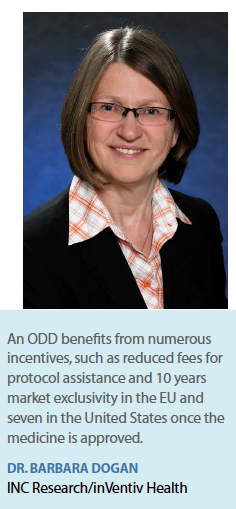 An ODD can only be granted for a medicinal product if it is intended for the treatment of a condition affecting not more than five in 10,000 persons in the European Union or less than 200,000 in total in the United States, the condition is life-threatening or chronically debilitating in nature, there is an unmet medical need, or the product can demonstrate a significant benefit over existing methods, Dr. Dogan says.
An ODD can only be granted for a medicinal product if it is intended for the treatment of a condition affecting not more than five in 10,000 persons in the European Union or less than 200,000 in total in the United States, the condition is life-threatening or chronically debilitating in nature, there is an unmet medical need, or the product can demonstrate a significant benefit over existing methods, Dr. Dogan says.
The second evaluation is with the marketing authorization application (MAA). Five years after approval or at extension applications the EMA can conduct an additional evaluation to assess if the orphan status criteria in the European Union is still fulfilled.
“Exclusivity may be lost if the marketing authorization holder (MAH) is unable to meet the demand, or the product is highly profitable," Dr. Dogan says. “Unlike their counterparts in the European Union, the FDA does not reassess the orphan drug status after approval."
Navigating Rare Disease Regulations
The regulatory frameworks for reviewing data and deciding on approvals were not designed specifically for rare diseases, with their smaller patient populations, says Jay Barth, M.D., chief medical officer at Amicus.
“Drug sponsors may encounter challenges trying to retrofit rare diseases into existing paradigms as opposed to having specific pathways or specialized reviewers for rare diseases," Dr. Barth says.
Pamela Swiggard, VP of regulatory affairs and quality assurance for Fibrocell, says the FDA is supportive of companies developing treatments for rare diseases and is committed to understanding the details about each program, which in turn, enables them to perform a thorough review and furnish comments.
“Additionally, the FDA offers provisions for financial assistance, including the FDA Orphan Products Clinical Trials Grants Program and waiver of the Prescription Drug User Fee Act (PDUFA) filing fee that can assist companies with ongoing product development costs," Ms. Swiggard notes.
“Following orphan designation, FDA offers a variety of regulatory tools that can facilitate and expedite orphan drug licensing such as priority review, fast-track, breakthrough, and accelerated approval pathways," says Dr. Dairine Dempsey, VP, strategic regulatory affairs, corporate management, ICON. “Likewise, the EMA has a number of options for expediting the approval process, e.g., PRIME and conditional approvals. Japan also has a priority review procedure for orphan drugs.
“In addition, regulators across the globe offer scientific advice specifically for orphan drug development providing orphan drug companies an opportunity to discuss all aspects of the development plan with regulators and payers as early as possible," she adds.
An orphan drug designation offers numerous incentives such as reduction of fees for protocol assistance, scientific advice meetings for the designated orphan drug, and 10 years of market exclusivity in the European Union and seven years exclusivity in the United States once the medicine is approved, Dr. Dogan says, adding that the application for an ODD is free of charge.
“It’s worth noting that one medicinal product can have several separate orphan designations for different indications, which will lead to several separate market exclusivities," she says.
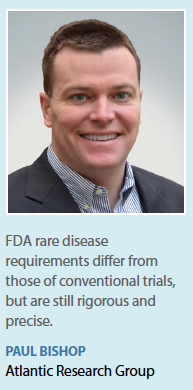 Ms. Swiggard adds that recently, the FDA also announced its Orphan Drug Modernization Plan. This new initiative has been designed to streamline the FDA’s review of Orphan Drug Designation requests, as well as help the agency manage its workload.
Ms. Swiggard adds that recently, the FDA also announced its Orphan Drug Modernization Plan. This new initiative has been designed to streamline the FDA’s review of Orphan Drug Designation requests, as well as help the agency manage its workload.
A Rare Designation
One hurdle companies face is achieving orphan designation, which is based on the definition of a rare disease and this definition differs in different regions, Dr. Dempsey says.
“Hence, what is an orphan drug in one region may not be in another," she says.
Dr. Dogan says the ability to show proven significant benefit during the application process is the most challenging.
“Regulators expect innovative products with clearly defined mechanisms of action that are unlike any existing orphan drugs," she says. “An existing or similar product with a better pharmaceutical form, an improved impurity profile, or a robust manufacturing process ensuring increased supply is no benefit."
The next challenge is proving superiority over existing orphan drugs during the MAA process.
“It is impossible to demonstrate the significant benefit of the newly authorized orphan drug only approved a few months prior," Dr. Dogan says. “There is a foot race between sponsors, which develop similar products for the same indication, to obtain market approval first."
Technical regulatory guidance, in other words therapeutic area specific guidance for orphan drug development, is also more limited than such guidance in traditional drug development, Dr. Dempsey says.
According to Paul Bishop, CEO, Atlantic Research Group, while FDA rare disease requirements differ from those of conventional trials, they are still rigorous.
“This can cause problems for sponsors without rare disease experience that may have trouble anticipating what the FDA will require or interpreting specific FDA requests in the context of orphan drug development," he says. “Climbing this steep learning curve can lead to delays and added costs that cut into the already narrow margins."
He cites an example of a biologics company that was seeking FDA approval for a hereditary angioedema drug already used in Europe. To meet requirements, blood plasma had to be sourced entirely from the United States. This required that it be collected 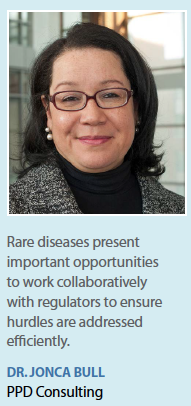 in the United States, sent to the Netherlands for processing in an existing plant, and then have the purified reagents shipped back to the states.
in the United States, sent to the Netherlands for processing in an existing plant, and then have the purified reagents shipped back to the states.
Mr. Bishop says it required taking extra steps to ensure the drug supply was protected, since losses would be expensive and incur long delays, but these steps supported the trial’s swift path to FDA approval.
According to Ms. Swiggard, possibly the greatest regulatory challenge for rare disease products is assessing a drug candidate’s performance based on a small number of patients.
Dr. Dempsey adds that identifying clinical investigators and sites and recruiting — and retaining —patients is particularly onerous for rare diseases, because of the small, highly heterogeneous patient populations and globally dispersed clinical expertise.
“From a trial design point of view, finding an appropriate comparator, even if that comparator is standard of care, can be a significant challenge in rare diseases where comparators or standard of care can differ greatly from one location to another," she says.
Ms. Swiggard says achieving an efficient development program may be more challenging, because often serious, not well-understood unmet needs of the disease must be addressed in the program’s design.
“Defining clinically meaningful research questions in advance of the trial — questions that respond to unmet needs and the plan to deliver the type and volume of data to answer them — can be difficult, especially when little is known about the disease or clinical endpoints; likewise, these questions and the data collection plan must be well-vetted due to the range of options and outcomes that could result," she says.
Ms. Swiggard adds that studies into the natural history of a rare disease are an essential part of determining clinical endpoints, including efficacy endpoints. Findings from these studies should be shared with the FDA as this information has the potential to be helpful in bringing new therapies to market.
Dr. Barth concurs, adding that with small patient populations there is usually a limited amount of information on natural history, which can make it harder to design studies or to compare data on treated patients with untreated historical controls.
When developing a rare disease product, regulators need to know if there is sufficient characterization of the proposed mechanism of action of the drug and the non-clinical pharmaco-toxicology, Dr. Bull says.
“Rare diseases present important opportunities to work collaboratively with regulators to ensure these early hurdles are addressed efficiently," she says.
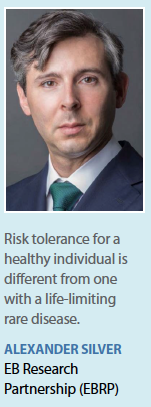 There is also a need to advance the use of novel trial design strategies, Dr. Bull says. Examples include the use of validated biomarkers and seamless programs that incorporate post-approval data as part of the overall clinical program to increase the speed of getting important new therapies to patients.
There is also a need to advance the use of novel trial design strategies, Dr. Bull says. Examples include the use of validated biomarkers and seamless programs that incorporate post-approval data as part of the overall clinical program to increase the speed of getting important new therapies to patients.
Children and Rare Diseases
According to Rare Disease UK, 75% of rare diseases affect children, and this adds a further complication to meeting requirements, particularly with regard to clinical trials.
In Europe, a paediatric investigation plan (PIP) has to be agreed upon with the EMA prior to starting the clinical program in children, Dr. Dogan says.
“MAHs of pediatric orphan drugs with a completed PIP benefit from additional 2 years exclusivity (in total 12 years)," she says.
Ms. Swiggard says children with rare diseases are a highly vulnerable patient population who deserve careful consideration in clinical trials.
“Prudent thought should be given to first assess a drug candidate’s safety in adult patients whenever possible or in those 12-18 years of age before to its evaluation in patients 12 years of age and younger," she says. “To further reduce risk before treating the youngest patients, modeling and simulation may be used in advance of a clinical trial to support design decisions. In addition, communication of a trial’s objective and its endpoints is vital with patients of all ages, and most particularly with young patients and their parents or caregivers."
Mr. Bishop says it’s important to balance benefit-risk in light of the very severe consequences rare diseases, such as developmental delays or a high risk of early death. Different ethical considerations need to be taken for infants compared with older children who are more aware of their conditions.
“Understanding these differences is essential for developing consent and patient education materials that meet stringent FDA requirements for pediatric trials," he says.
Dr. Bull adds that the impact on growth and development is a particular focus for pediatric populations.
“This presents special challenges for rare disease programs to address clinical monitoring strategies that collect long-term data for adverse event surveillance," she says.
Resolving Challenges
It’s important that the regulatory framework for rare diseases take into account that risk is relative, says Alexander Silver, co-founder, executive chairman, and CEO of the EB Research Partnership (EBRP).
“Risk tolerance for a healthy individual is different from one with a life-limiting rare disease," he says. “For example, walking down the street has much greater risk for someone living with Epidermolysis Bullosa (EB). Think of the ramifications if he or she trips or gets knocked over — this could take all the skin off a portion of that person’s body. When the baseline is pain and 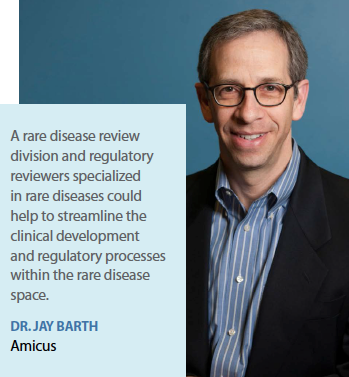 shortened lifespan, the framework for thinking about a treatment must take that into account."
shortened lifespan, the framework for thinking about a treatment must take that into account."
Mr. Silver adds that this does not mean being careless, but rather that time for someone with a shortened lifespan is a more rapidly depreciating resource and the alternative to not doing something is death.
“As such, a framework needs to be more forward leaning, have less red tape and different standards — number of people in a trial, length of trial, outcome measurements, etc. — for someone with a rare disease," he says. “It is ludicrous to be where we are today and not have this already delineated."
Dr. Barth says a rare disease review division and regulatory reviewers specialized in rare diseases could help to streamline the clinical development and regulatory processes within rare diseases.
“Further enhancing the alignment among different regulatory agencies globally is also critical in rare diseases, since the patient numbers are limited and conducting a clinical trial that satisfies various agencies is important to minimize the number of trials needed in a clinical development program," he says.
Dr. Dogan says ministries of health (MoH) across Europe have started initiatives to get a better understanding of rare disease, such as collection of epidemiological data by the creation of a national registry, implementing new screening programs, organizing national rare diseases awareness campaigns, creating national expert centres, and supporting the patient organisations. The MoHs support access to new treatment options by funding clinical trials and granting access to compassionate use programs.
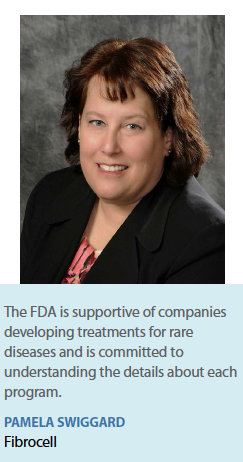 She points to the European Commission’s Horizon 2020 program, which is a two-step evaluation process.
She points to the European Commission’s Horizon 2020 program, which is a two-step evaluation process.
“The goal is to invest in the development of innovative medicines, collaborative research projects, or partnerships between Europe and developing countries," Dr. Dogan says. “The program is funded with €7 billion ($8.29 billion) over seven years — 2014 to 2020."
Mr. Bishop says extending market exclusivity for orphan drugs would do more than anything else to encourage more participation.
“Adjusting efficacy standards or endpoints to gain rare disease indications for existing products and to make possible development of completely new drugs is also helpful, but it can be difficult to convince the FDA and Congress to do it," he says.
This is where patient advocacy groups can be helpful, by providing in-person insights to help regulators and legislators see a rare disease in a different light, he says.
According to Dr. Dempsey greater involvement of patients from the very beginning of the drug development process enhances outcomes of rare disease clinical trials, particularly in the establishment of meaningful study endpoints for both regulators and reimbursement bodies. Sponsors and CROs work closely with patient organizations and patient advocacy groups to design better rare disease trials.
“Patient involvement has also been embraced by the EMA with three patient organizations represented on the Committee for Orphan Medicinal Products and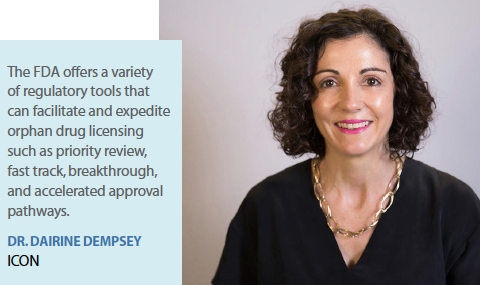 a current Vice-Chair is from the European Organisation for Rare Diseases (Eurordis)," she says.
a current Vice-Chair is from the European Organisation for Rare Diseases (Eurordis)," she says.
Important advances are the 21st Century Cures Act and the recognition of the patient voice, Dr. Barth says.
“Patients have the experience and can speak to the impact of the disease on their lives and the effects of treatment of their disease, especially in terms of what defines a clinically meaningful effect for them," he says. “Further input from patients can only help in rare disease and regulatory agencies are inviting patients to provide that information and education about the disease."
Dr. Barth also notes that there are avenues for breakthrough therapy designation (BTD) in the United States and PRIME in Europe that allow for more frequent dialogue with regulators and expedited pathways to market where there is significant unmet need, which is often the case in rare diseases.(PV)
~~~~~~~~~~~~~~~~~~~~~~~~~
Overcoming the Reimbursement Challenge
The often cost-prohibitive price tag on orphan drugs contributes to restrictive behaviors for providers, payers, and patients alike.
Ana Stojanovska
 VP of Reimbursement & Policy Insights, Xcenda
VP of Reimbursement & Policy Insights, Xcenda
Getting an orphan drug approved is just part of the battle; the next is ensuring reimbursement. While rare disease innovation makes a difference for small patient populations, more breakthrough therapies available mean more plan population increases and plan costs for payers, says Ana Stojanovska, VP of reimbursement & policy insights at Xcenda, a part of AmerisourceBergen.
Ms. Stojanovska says orphan products have a far greater impact on plans than their small patient populations would suggest. Given this, payers are weighing the potential impact of expanded indications and how treating larger patient populations with these drugs would increase the budget impact on their plans.
“In addition to their role as first-line treatment for patients with rare diseases, research and development focused on orphan products is also advancing treatments within broader disease states," Ms. Stojanovska says. “For example, rare disease innovations can offer additional treatment options for larger patient populations, such as those with cancer, multiple sclerosis, and cystic fibrosis."
The financial burden on payers and increased plan management by payers for orphan drugs means manufacturers need to emphasize and prioritize proof of clinical and economic value.
Manufacturers need to articulate their value story to many stakeholders, including payers, providers, and patients in a way that addresses how each one prioritizes and perceives value.
This value story needs to be bolstered by real-world evidence of successful patient outcomes, and if applicable, include the benefit of multiple indications to ensure reimbursement.
According to Dr. Dairine Dempsey, VP, strategic regulatory affairs, corporate management, at ICON generating the data that will satisfy payers that the drug is value for money in inherently small patient populations as well as generating the data that meet the regulatory expectations requires early planning, as well as creative and alternative trial design strategies.
Taking Proactive Steps
To drive reimbursement, manufacturers need to start with a well-planned commercialization strategy. Formulating a winning strategy means planning for the development of data-driven value propositions that resonate with all stakeholders — payers, providers and patients, Ms. Stojanovska says.
To start with, companies should map the patient journey, from the diagnostic hurdles that patients face, the physician specialists they visit who manage treatment and ongoing care, and what resources exist are all important to understanding the patient’s treatment journey.
“This process will identify barriers to treatment and help manufacturers think through strategies to mitigate or eliminate access challenges for patients," Ms. Stojanovska says. “In addition, manufacturers can identify the touch points where they can interject the most value with their new therapy."
Companies should also evaluate patient support service programs that can address potential barriers to access, affordability, and adherence.
Education is critically important for payers and providers, and manufacturers should be prepared to share clear and concise information to enhance understanding of the therapeutic area and highlight product value that is backed by outcomes data.
Many orphan drugs require a unique delivery method. Building a distribution strategy and developing strategic relationships with distributors, pharmacies, and wholesalers is essential to ensuring alignment in the delivery of care. Depending on the product, manufacturers may evaluate a specialty pharmacy strategy as part of their commercialization plan. Payers are increasingly attracted to the data that specialty pharmacies can provide for these types of products.
Manufacturers should also employ post-launch strategies for tracking outcomes and monitoring reimbursement to stay on top of changes in the orphan drug market and drive continued product access.
Whether it is an adherence strategy and evolving the product message as real-world data emerges, or tapping patient advocates and advisory boards to monitor payer perception and provider education, product differentiation does not stop at launch.

















